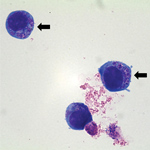Volume 25, Number 4—April 2019
Etymologia
Etymologia: Anaplasma phagocytophilum
Figures
Downloads
Article Metrics
A species of tickborne bacteria that causes human granulocytic anaplasmosis, Anaplasma (from the Greek an- [“without”] + plasma [“shape”]) phagocytophilum (named for its affinity for growing in neutrophils: phagocyte + Latin phile [“loving”]) has gone by many names (Figure). First it was named Rickettsia (for Howard Taylor Ricketts) phagocytophilum, then Cytoecetes (for its similarity to Cytoecetes microti) phagocytophilum, and then Ehrlichia (for Paul Ehrlich) phagocytophilum. More recently, E. equi and the agent of human granulocytic ehrlichiosis (now anaplasmosis) were combined with E. phagocytophilum as A. phagocytophilum.
References
- Kim K-H, Yi J, Oh WS, Kim NH, Choi SJ, Choe PG, et al. Human granulocytic anaplasmosis, South Korea, 2013. Emerg Infect Dis. 2014;20:1708–11. DOIPubMedGoogle Scholar
- Woldehiwet Z. The natural history of Anaplasma phagocytophilum. Vet Parasitol. 2010;167:108–22. DOIPubMedGoogle Scholar
Figure
Cite This ArticleOriginal Publication Date: February 28, 2019
Related Links
Table of Contents – Volume 25, Number 4—April 2019
| EID Search Options |
|---|
|
|
|
|
|
|

Please use the form below to submit correspondence to the authors or contact them at the following address:
Ronnie Henry, Centers for Disease Control and Prevention, 1600 Clifton Rd NE, Mailstop E28, Atlanta, GA 30329-4027, USA
Top